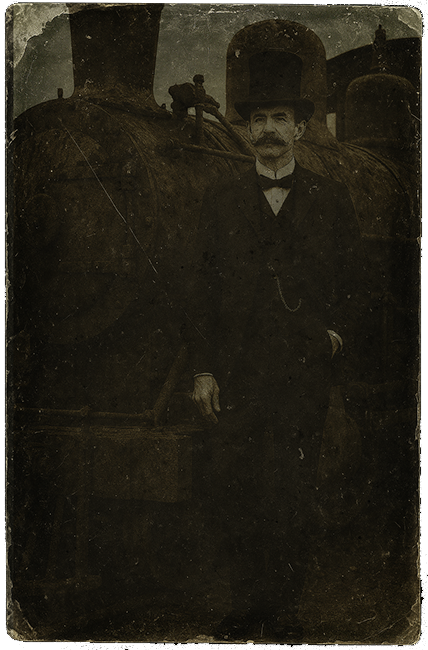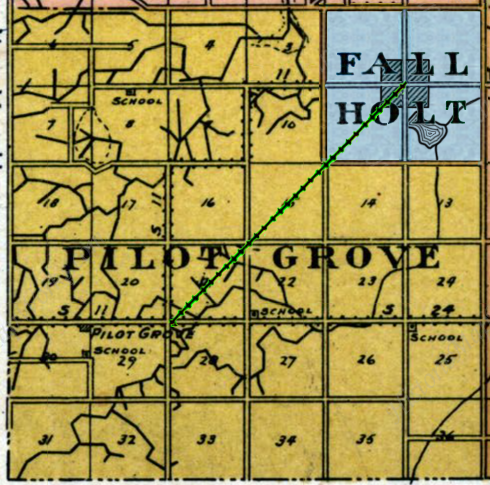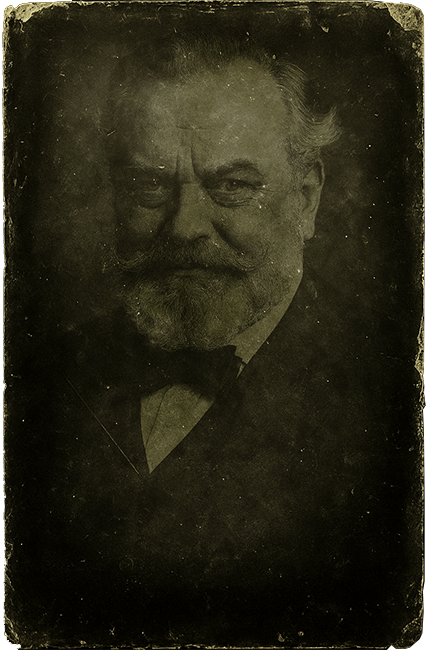
|
|
A rare full-body image of Dr. Xavier Holt standing proudly before the inaugural engine of his privately financed rail line. This photo was taken just weeks before the first trip between Fallholt and Pilot Grove. According to early council records, Holt paid for the engine outright—then named it The Sovereign. |
A fine and steady trade between Fallholt and Pilot Grove began in earnest, consisting of corn, wheat, furs, and of course choice goods from the Cities (curated and vetted by Gellar Svensson personally) that were previously unavailable to small rural towns like Pilot Grove. Xavier Holt himself had become the primary engineer and railmaster of Dr. Holt’s Short Line Railroad Company and enjoyed every ride. Mutual prosperity ensued, and with it came a willingness among Pilot Grove’s citizens to be indifferent to Fallholt’s rather unorthodox ethos.
By 1886, word of Holt’s successful modest five-mile passenger and cargo rail had spread to the Cities. Eager to bring more commerce to their own towns, Holt was overwhelmed with requests from surrounding counties to consider a deal to connect more rail to Holt’s small, private system.

|
|
Holt's route for a his own short line connecting Pilot Grove to Fallholt. |
Meanwhile, Blue Earth was mere months away from the longed-for track from the U.S. Roc Line Railroad to reach town from the north in the summer of 1887. During this time, many of Blue Earth’s citizens had already been privately absconding to Fallholt to ride Holt’s well regarded curiosity. Once many of the Blue Earth locals began spotting each other lurking about the shops at either end of the rail, it was the worst kept secret in Blue Earth that there was admiration for what Dr. Holt had accomplished in a short amount of time and hoped that the rail finally coming to their town would bring the same prosperity.
In January 1887, carrying momentum from the modest success of Dr. Holt’s Short Line Railroad Company and weighing offers to extend and expand his private rail to surrounding townships and counties, Holt approached Blue Earth once again to extend his rail to them first, as a gesture of goodwill toward his former town. It was well known by this time that even in Blue Earth, Holt’s rail was very popular and it was no longer considered controversial to say as such. This forced the Blue Earth town council to strongly consider this arrangement, and with the U.S. Roc Line Railroad arriving soon and then heading south to Elmore and into Iowa, having multiple rail routes available by linking to Fallholt seemed like a win-win at this point.
The owner of the U.S. Roc Line Railroad, T. Gordon Cornelius, soon learned of Holt’s second presentation to the Blue Earth town council. Cornelius was already agitated about an upstart outfit like Holt’s upstaging him in an area well ahead of their own scheduled arrival in bringing his rail to Blue Earth. He did not like this sudden emergence of competition.

|
|
T. Gordon Cornelius, rail baron and owner of the U.S. Roc Line Railroad. |
With many friendships forged by visits north to the Cities from traveling corn farmer Gellar Svensson, surveyors, stonemasons, craftsmen and laborers numbering in the dozens signed contracts to come to Fallholt in September of 1877, and construction began on the straight stretch of rail heading south-west toward a proposed new rail depot in Pilot Grove, the terminus of this short line, which was also being built at Holt’s expense.
In early April of 1887 and with his own track around 20 miles away from reaching Blue Earth, Cornelius once again flexed the U.S. Roc Line Railroad’s muscle and threatened to bypass their town entirely and continue the track straight on to Elmore if they made any sort of railroad deal with Xavier Holt. Blue Earth buckled under the weight and might of Cornelius’ gravitas and reluctantly rejected Holt’s offer for the second time.
A fair portion of the Blue Earth citizenry were displeased with the political buckling and rejection of Holt’s offer, having seen with their own eyes the great success of his small railroad and began to be of the view that Fallholt was not being dealt a fair hand in this matter, despite their long-standing disagreement, and public sentiment began to disfavor Cornelius’ Railway that was long anticipated and on the doorstep of town, with Cornelius being seen as greedy and unwilling to entertain competition in the eyes of many.
By May of that year, Holt had begun discussions with railway companies about connecting his system up as far north as Mankato and to multiple towns along that route.
With one eye on Holt, Cornelius’ new Blue Earth station officially opened on June 1, 1887, and welcomed the first locomotive from the U.S. Roc Line Railroad to minimal fanfare– only wealthy locals who could afford tickets to ride to the cities, and rail enthusiasts attended. By this time, public opinion of Cornelius had soured, and this drained much of the enthusiasm and produced lower than expected ticket sales and freight shipments.
The recent turn of events infuriated Cornelius, as he continued building his rail southward toward Elmore through the summer as planned.
On October 17, 1887, a summit meeting was held, initiated by Cornelius and his representatives, at the Blue Earth town hall. The Fallholt Town Council as well as Blue Earth Mayor C.K. Moyer, all bore witness to Cornelius begrudgingly ask to bring Holt’s original offer to bring his rail from Fallholt to Blue Earth back to the bargaining table, citing the clear financial boon to his Railway and the cost of this new spur track being borne by Holt himself. Fallholt and Blue Earth struck a deal to begin construction on the new rail segment the following Spring of 1888, under Holt’s original terms and with Cornelius agreeing not to interfere with this connecting spur track. Holt put his other railway negotiating on hold to devote his time and resources to the newly greenlit project, which was his pet project all along, much to the dismay of the other interested parties.